Provided by John E. Phillips
After 27 years of elk hunting, 20 bull elk taken and more than 100 successful elk hunts filmed, Troy Ruiz loves elk hunting during the season. A veteran videographer and hunter who has worked with Mossy Oak and now Primos Hunting in their production departments, Ruiz says his title today is field producer for Primos Hunting Calls and TV shows and senior video editor and producer for “Primos Truth about Hunting.” He started filming and hunting elk in 1994 when he began working for Mossy Oak. As Ruiz says, “I learned on the fly about elk hunting and videoing. People told me that hunting elk was just like hunting turkeys, which I loved. That information proved true - except elk can smell you.”
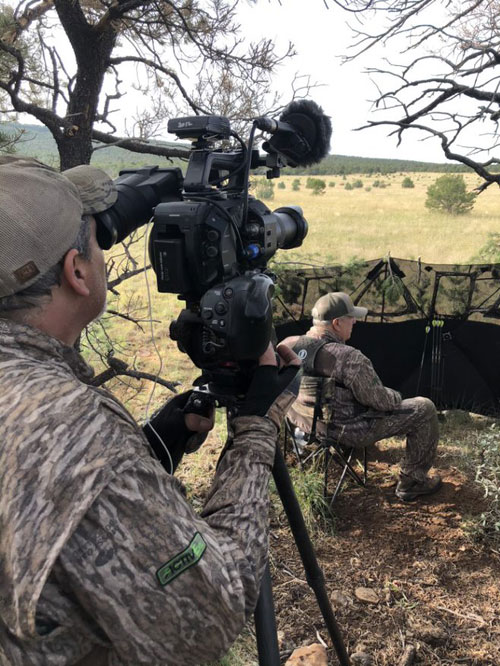
How Troy Ruiz Hunts and Videos Elk
The biggest difference in Ruiz’s hunting and filming elk today compared to the way he approached his craft back in the 1990s is the weight of the gear he has to carry. According to Ruiz, “The cameras we’re running now are all digital, so we don’t have to carry an array of Betacam SP tapes in our turkey vests, giant In Time brick batteries and heavy tripods. On one of my first elk hunts with Mossy Oak, Tack Robinson and I were hunting in the Gilas in New Mexico with Bill Eppers, Pete Shepley, the president at PSE, and Corky Richardson, a world-class elk hunter and caller. After a morning hunt, I weighed my turkey vest where I carried all my equipment, and it weighed 48 pounds. Then I weighed my camera and my tripod I carried in my hands, and they weighed about 60 pounds. So, I was actually carrying about 110 pounds of camera gear up and down mountains and across some flat ground.”
The equipment Ruiz carries today is: a 12-pound tripod, an 8-pound camera and one battery and several SD cards that weigh ounces. When asked how many elk hunts he’s videoed, Ruiz explains, “Here at Primos Hunting during elk season, I’ll video six to seven successful elk hunts a year. But, to get that many hunts, I start hunting from the first of September until the second week of October – probably 40 to 50 days a year.”
Sometimes Ruiz moves out in front of the camera and becomes the host. “When I was working at Mossy Oak, only a couple of people filmed for Mossy Oak. So, we didn’t have time to get out in front of the camera to do any of the calling or shooting. But once Mossy Oak hired more field producers, we started doing more elk hunting. Oftentimes people would tell me, ‘I want to get in the outdoor industry and do what you do.’ Then I’d ask them, ‘Why do you want to get in the outdoor industry?’ and they’d usually answer, ‘Because I love to hunt.’ Then I’d explain, ‘Well, you don’t want to do what I do because the least thing I do is hunt.’ My main job is filming other people hunting, and turning their hunts into stories that we can run on TV shows or make into videos.”
“Video field producers never try to get a hunter to hurry up and take an animal, so they can hunt. As a producer, you’re not a guide, and you’re not a caller or a shooter. You have to be conscious of getting the video of an elk coming in and the hunter making the shot with a bow or a gun and your telling the story of the hunt. Today, you can go on YouTube and find hundreds - perhaps thousands - of videos that are what I call, ‘Watch me take an elk.’ A good video is similar to a good book: you have a blockbuster cover on that book and a quality summary of the hunt on the back cover that’s about three paragraphs long. But, if you take that same book and rip all the pages out of the middle, all you’ve got is a pretty book cover and a back story. You don’t have the most of the story from the pages in the middle. When I’m shooting a video, I want the viewers to see what I see, smell what I’m smelling and feel the excitement that the hunter’s feeling to pull them into the story. I have to build my video much like a writer builds his magazine articles or books to hold the reader’s attention from the very beginning of the video all the way to the end. Usually during elk season, I’ll be the last person to hunt.
“After 27 years of elk hunting from the beginning of elk season until the end of elk season, I’ve taken somewhere around 15-20 bulls myself. People often ask me, ‘How big is your trophy room? And how many of those bulls do you have mounted?’ My answer is all my bulls are European mounts with the skulls and the antlers of the bulls intact. My wife likes to hunt, too. Because I hunt so much, so hard and so long, filming elk, mule deer, whitetails, turkeys and all the other animals that we hunt, I want to keep my home a place where I can disconnect from hunting altogether – except for my European elk racks.”
Why Use the Drop Back System of Taking Bull Elk
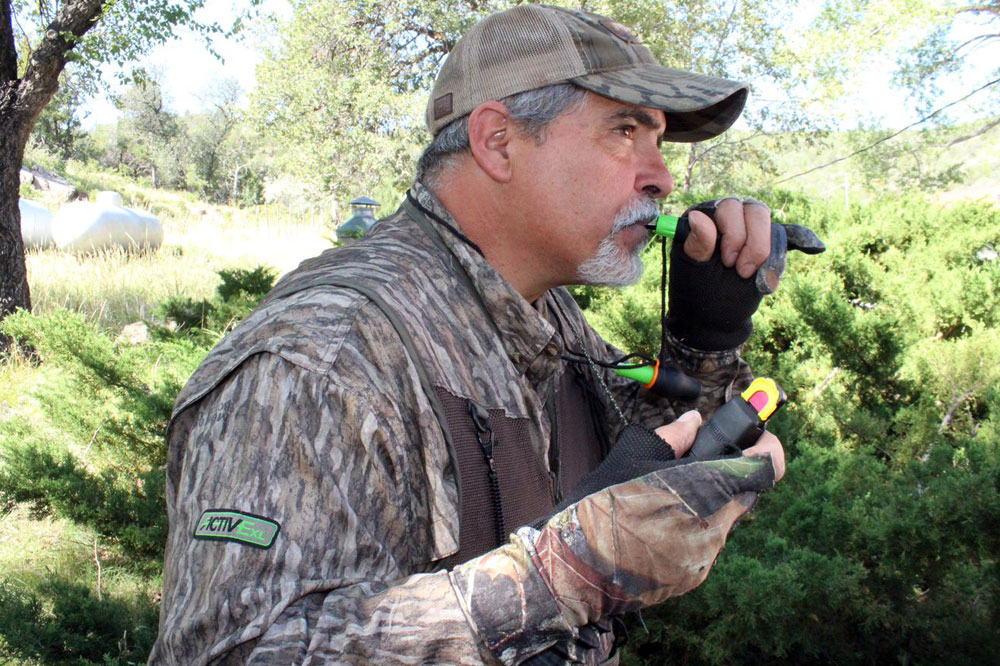
What’s the secret to taking bull elk?
Ruiz: Two friends of mine - Will Walker and David Carden - figured this out many years ago. We’ve used this same technique to call in turkeys. The real secret to this - especially when bowhunting elk, is to make that bull think something’s going on in his house that he doesn’t understand. For instance, if you’re in your bedroom and hear somebody in your kitchen frying bacon and eggs, you have to get up and go see what’s happening. That’s the same approach that we used for getting elk in close. We want to cause the bull to leave where he is, and come and investigate some cows and maybe a bull that he hasn’t realized is in his area.
The second step to this technique is for the bull to be surprised when he sees the hunter, so that he’ll stop, look and try to determine what the hunter is, which gives the shooter time to make the shot. We call this the drop back method of elk hunting. We’ll set the hunter up from 50-150 yards in front of the caller. Once the elk comes in to the hunter, especially a bowhunter and sees him or her draw the bow, he’ll stop and try to determine what he is. That’s when your Mossy Oak camouflage really pays off. As the bull looks at the hunter, sees him or her, but can’t identify what that hunter is - then in that split second while that bull’s stopped and looking at you, you must take the shot. This same tactic works when you’re deer hunting. If an elk or a deer can see where calls are coming from, the animal won’t come in, so the key to this system’s success is to have the caller as far away from the hunter, that the elk can’t see him, but close enough that the caller can see both the elk and the hunter. A good caller will make that elk come looking for where the calls are coming from, so that the elk’s attention isn’t on the hunter.
The classic example of how all this works was the hunt I did with Corky Richardson in the Gilas of New Mexico. Corky is one of the best elk hunters and callers I’ve ever known, and he’ll do what he must do to take a big bull. I was sitting behind Corky, he was calling, and the elk was coming right to him. Corky knew the bull would spot him as soon as the bull topped over the ridge. Suddenly, Corky jumps up and starts running down the back side of the ridge past me. I couldn’t see him or the elk, but in a few minutes I heard the “whack” of the arrow hitting the bull.
You talk about a mad cameraman! I’d been carrying those 110 pounds of camera gear up and down mountains in the Gilas to get a video of a bull elk coming in and Corky shooting him. I didn’t get any footage at all. However, Corky got his elk. Our main key to success when taking bulls with bows for TV is to always have the caller behind the hunter, but within sight of the hunter and the bull. The caller can move to get the bull to go in front of the hunter, rake trees with an elk horn, give several different types of cow calls and sound like a small herd of elk. Then the bull will come and investigate. When the hunter takes the shot, the bull’s surprised. Even though he’s hit with an arrow, he doesn’t really know what’s happened and won’t go very far.
Often, when filming, I can get the bull coming in and the hunter taking the shot and footage of the bull running or trotting off, stopping and falling over. Today we’ll usually have two cameramen, a caller and a shooter when we hunt elk for TV and videos. Yes, we have a parade going through the mountains, but that often helps us, because then we sound like a small herd of elk when we’re moving.
What Troy Ruiz Learned about Bull Elk Taken When Bowhunting
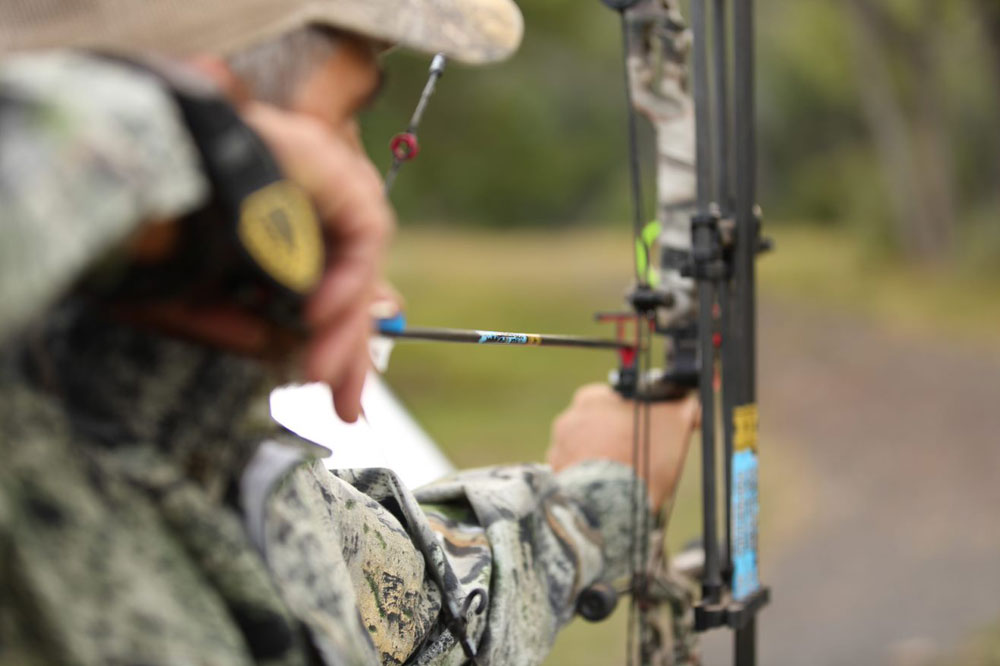
On a hunt that took place in 2008, three friends of mine and myself were hunting in New Mexico on a ranch we’d hunted on for several years. We were still trying to learn how the elk moved on this ranch, why they moved, and to where they usually moved. I’ve found another key to success in consistently taking elk year after year is to hunt the same place for several years. Then you can determine where the elk are at certain times of the year, and where they like to bed, feed, water and wallow, making them more predictable in following years – if hunting pressure changes, the climate changes, or a fire or cutting timber is happening in that area.
On this hunt, we’d learned that the dominant wind on that ranch either came from the south or the southwest. Then we wanted to get into an area where a herd of elk were bedding. We snuck right into their bedroom and gained a lot of knowledge about what this particular herd of elk did. We learned the elk didn’t all lay down on the ground when bedding - often some bulls would be standing up - and from time to time, some of the bulls and cows would get up, go down the mountain to get water, return up the mountain and either bed down or stand around with the rest of the herd. The mountain we were on and the place where the elk were bedded allowed the elk to easily and quickly go a little ways from their bedding site for these drinks of water. We learned the bulls often would wait until the cows were bedded down, leave the cows, get drinks of water and return to where the cows were bedded. I’ve learned that when I hear plenty of bugling, more than likely those elk and their cows are on the move. However, when I only hear an elk bugle about every 4 or 5 minutes then, more than likely, the elk are bedded down and the bulls even may be bugling from their beds.
When my friends and I got close to the herd and the spot we wanted to hunt, two of my friends dropped back 75 yards and got behind and beside some lava rock. My friend Chris and I maneuvered as close as we could to the herd and hid in the lava rock. We spotted a bull bugling while lying in his bed. My friends Brad and Mike set up about 75 yards from us, started moving around and began calling - sounding like a small herd of cows and a spike bull. Where I was set up, I was in the shade and in the rocks with only one small pine tree, about as big around as my thigh, in front of me. When that bull heard all that commotion behind me, he started coming. I waited until he stopped behind that pine tree, so he couldn’t see me draw.
Now, another secret to taking an elk with a bow is don’t try and be a super-strong guy to the point that you have to wrestle the bow because the string weight is so heavy that you have to fight to get it back to full draw. You want to shoot the poundage that allows you to come to full draw with the bow in front of you and that makes that draw weight easy to pull. Then, if the bull does see you, all he’ll see is you pulling that string straight back - not fighting with the bow to get it back to full draw.
As I started to pull my bowstring back, the bull spotted me and stopped 6 feet away from me when I reached full draw. Because we were in an area where the bull felt comfortable, he just stopped and looked at me. I aimed center mass right at the crease of the bull’s shoulder. Once the bull took the arrow, he bucked like a bucking horse coming out of a chute at a rodeo. I started calling to him immediately because when a bull didn’t identify you as a hunter, he didn’t know if another bull had snuck in and stuck him with one of his antlers, or if a stick had poked him in the side. He really didn’t understand what just had happened.
Now, that was the good news. The bad news was, when we caped and quartered that bull, a blinding rainstorm hit, and we had sleet, hail and lightning all around us. We also hadn’t brought pack frames in with us, which was a major mistake. Instead, we had to put the meat on our shoulders to carry it out. But when remembering that hunt, I never had a bull that close to me – only about 6 feet away. When a bull’s that close, you must concentrate on the spot you want your arrow to hit. And that’s another secret to successful elk hunting: once you’ve identified an elk as a shooter, don’t look at his horns anymore but instead concentrate on the spot that you want your arrow to hit. Then if the bull stops and gives you a shot, all you’ve got to do is come to full draw and release the arrow.
Why and How Troy Ruiz Hunts the Same Places Each Year for Elk
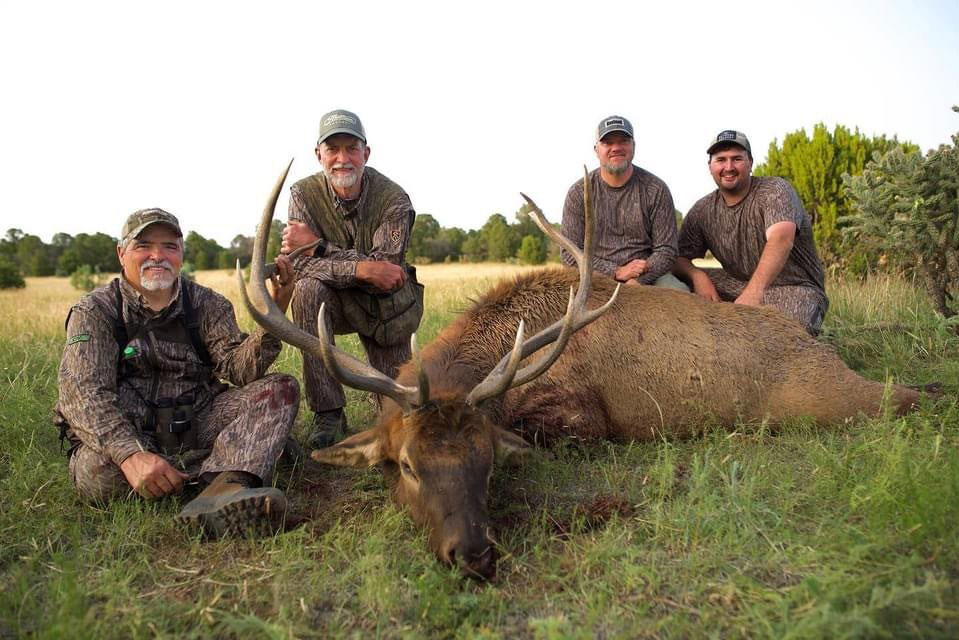
Every year I’ll usually hunt three different states - New Mexico, Colorado and Montana - and I try to hunt the same ranches every year. Animals are creatures of habit - especially turkeys, white-tailed deer and elk. Elk most always will do what they’ve always done - as long as hunting pressure’s the same, the food source is the same, and the water is the same. When a drought occurs, and the water or the grass aren’t in the same places they’ve always been, or perhaps there’s more hunting pressure in the area you’re hunting than ever before, then the elk will move.
Another factor that’s important, if keeping a journal, is recording the direction of the dominant wind on that ranch. Although winds change from time to time, at least you know what wind direction you should have on the days you hunt. You know how the thermals work going up and coming down the mountains and what time the sun usually comes up. I keep a journal with this information, whether I’m hunting elk, deer, ducks or any other critter. I’m really diligent about keeping those notes and having past histories of places I’ve hunted. This information is a tremendous help if I return to that same spot during following years. I’ve learned to trust that information I have in my log, and that allows me to hunt with much more confidence than if I haven’t collected that research. Too, each place you hunt often has a unique characteristic that’s specific to that place.
Many old-time elk hunters will tell you that you’ve got to beat the elk to the tops of mountains to get in close and take them just before or when they’ve bedded down. One ranch I elk hunt has elk that go up a mountain before daylight due to the wind currents coming down the mountain, allowing them to smell everything that’s in front of them. Usually, the lead cow – probably the smartest and the wariest elk in the herd - will be the first one to go up a mountain. So, on this ranch, we don’t leave camp until about 7 or 8 a.m., depending on where we have to go to find the elk and how far we’ll have to walk to get to that spot. So, we let the elk start walking up the mountain. Then based on the wind direction, we know that when the sun comes up, the thermals will start coming down the mountain. As long as we stay behind the elk and have the wind in our faces, we can walk right in to their bedrooms without their smelling and seeing us.
On one hunt where we used this technique, we were walking up the mountain, and I spotted the tip of a bedded elk’s antlers. We were so close to the elk that Will Primos, who was going to do the calling, crawled on his belly for about 75-100 yards to a place where he’d found some rocks to get behind to call the elk, watch the hunter and see the elk coming in without the elk’s spotting him. I was able to sit close enough to Will to film his calling and see the bull coming in, while Jordan Blisser, another videographer filmed the hunter who would be taking the shot. Once Will began calling, a bull got up out of his bed and started walking straight to the shooter, stopping at 22 yards, when the shooter made the shot. By waiting until the sun comes up, causing the thermals to move down the mountains, we often can slip right into the area where the elk are bedded and get close to the elk undetected.
Why Log Hunt Information to Effectively Hunt Elk and the Importance of Water
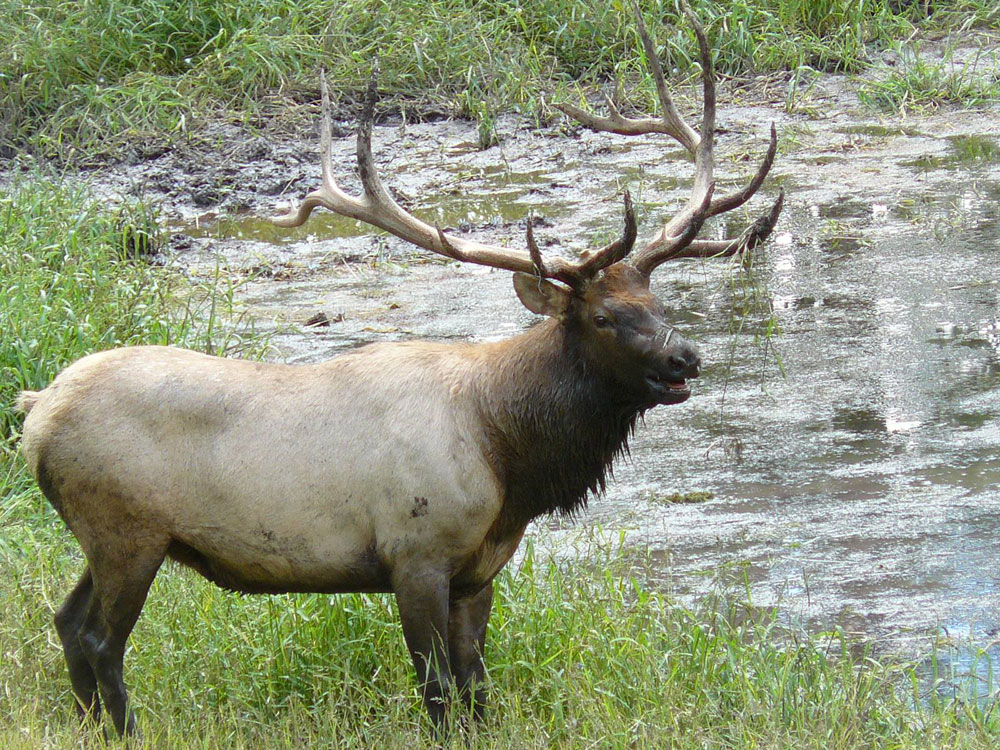
Before hunters had smart phones, Ruiz kept paper and pencils with him to log information about his hunts. “But when cell phones came in, I started logging my information from each hunt on my cell phone because I carry a phone everywhere I go. I always write notes when we’re filming to have a written record of what we’re filming, and who’s done what. Those notes help me put what we’ve filmed together in chronological order when we get back to produce the video or TV show. But I’m also adding hunting information.
I usually have the name of the ranch where we’ve hunted, what part of the ranch we’ve hunted, where we’ve found the elk, and when we’ve harvested the elk. Most of the elk that we take are harvested between 11 a.m. and 2 p.m. I also write down what time we’ve left camp, how far we’ve had to walk, what wind direction we’ve had, who the hunter and the caller is, who the videographers are, and what’s the moon phase and any other notes that are relevant to hunting that same ranch again. Then I list a timetable of what’s happened each day. If you’re watching one of our TV shows or our videos, you’ll see that we usually take the elk within 24 minutes. However, to get that footage, we may have to hunt five or more days. Without my notes that I type onto my phone, I’ll have a tough time remembering what’s happened each day and which footage I may want to use on what day to produce the show.
Another advantage that has helped us be successful is we don’t try and race the bulls to the tops of the mountains. Then we can come in below the herd and use the wind to allow us to get as close as possible to those bulls before we start calling or trying to take them. Rarely do we ever spook any of the elk we’re hunting. Therefore, we’re putting very little pressure on the elk, and as most people know, the less pressure you put on a herd of elk, the greater your odds for taking a nice bull. The other thing that I’ve noticed keeping my journal is that if you want to shoot a satellite bull or something less than a trophy bull, you may be able to take one by racing him to the top of a mountain. However, what we’ve learned is if you’re going to try to take the herd bull or another trophy bull that’s moving with that herd, generally, those big bulls will stay close to those cows. So, the closer you get to the cows without being seen or smelled, the better your odds are for taking the biggest bull in the herd.
The Importance of Water
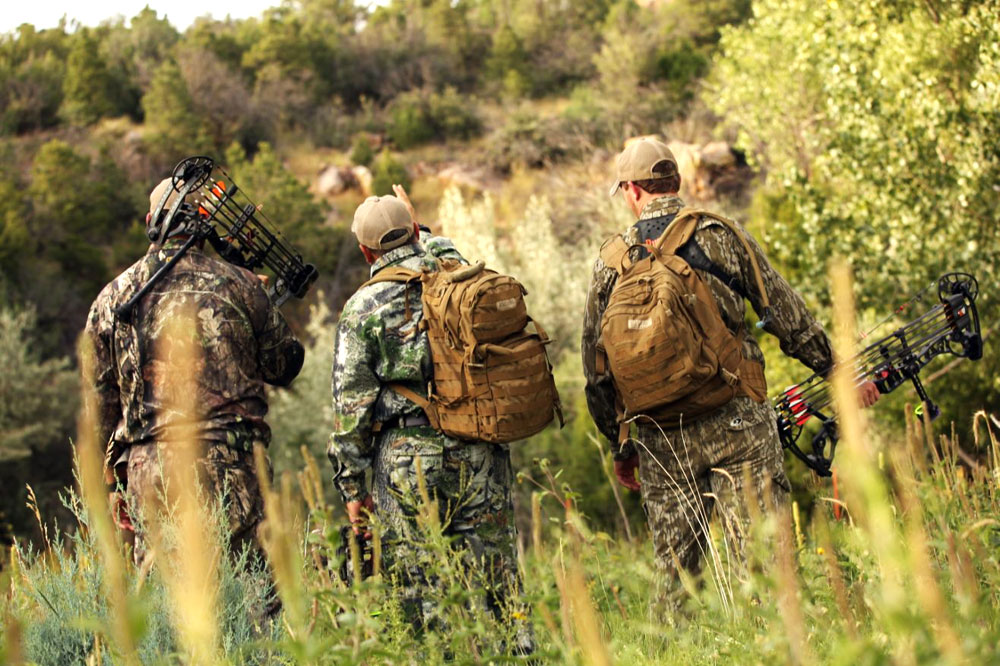
From observing bulls and cows when they’re bedded down, we’ve learned that when the herd reaches its bedding area, the bull usually will stand up most of the time, until he feels comfortable that he’s got all his cows where he wants them to be when they bed down. At that point, the bull may go ahead and bed down or he may go to get water - especially in the early season.
On this hunt, we knew the elk were going to one water hole on the ranch because we’d heard them at this water hole all week long. But we were so busy hunting that we didn’t want to go to the water hole and possibly sit there all day long in hopes of seeing a big bull. Will Primos happened to be the last person in our group who was hunting that week, and after two failed attempts to take a bull, I told Will, “Let’s just go to the water hole, set up, and see what happens.” But Will said, “Troy, we know where these elk are bedded, and we should be able to move in close enough for me to get a shot at a bull.” I explained to Will, “If we spook one of the cows in that herd, then that whole herd will get up and run for 23 miles across the prairie to the other side of the ranch. We’ll have to wait an entire day before we can try to hunt them again. I’ve been listening to these elk all week long, and yesterday I heard what I believe to be one of the better bulls leave the herd and go to get water while the cows were bedded down.” So, Will finally agreed for us to go to the water hole to set up and hunt.
We sat down on the ground, and within 3 minutes of us getting set up, we spotted this big bull coming to water. Will had built a small ground blind out of natural branches and brush, and I set- up my camera a little way behind him. Two friends had come with us and set up at various places where they could see Will and/or see the bull. Since the time was the middle of the day, we didn’t know when to expect a bull. We planned to eat lunch in the shade. I took my sandwich out of my pack and just before I could take a bite, I spotted elk legs coming toward the water at about 200 yards away on the next ridge. I whistled to Will, and he let me know he saw the bull and was getting ready for the shot. He let the bull get into the water and bugle two or three times before he took the shot. That bull then started running out of the water, but when I looked up, I saw a bigger bull coming toward the water. I think he had come down from the herd to see what was happening. I told Will later, “I believe that as hot as this weather is, and as many bulls as we’ve seen in this herd of elk, you could sit here on this water hole and watch bulls leave the herd, come down to this spot to get water and then go back to the herd.”
What I learned from that elk hunt was when there’s a good source of water, the weather’s extremely hot, and you're attempting to take a big bull out of a large herd of elk, when the herd bull gets his cows settled down in their bed, he’ll often come to water. After he drinks, he’ll return to the herd. And, if he hears other bulls watering before he decides to go get a drink, then he may go down to the water to try to run those bulls off and to get a drink himself.



























